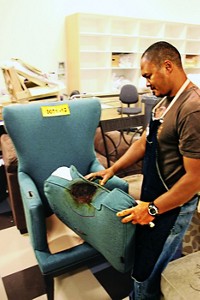Advertisement
Grab your lab coat. Let's get started
Welcome!
Welcome!
Create an account below to get 6 C&EN articles per month, receive newsletters and more - all free.
It seems this is your first time logging in online. Please enter the following information to continue.
As an ACS member you automatically get access to this site. All we need is few more details to create your reading experience.
Not you? Sign in with a different account.
Not you? Sign in with a different account.
ERROR 1
ERROR 1
ERROR 2
ERROR 2
ERROR 2
ERROR 2
ERROR 2
Password and Confirm password must match.
If you have an ACS member number, please enter it here so we can link this account to your membership. (optional)
ERROR 2
ACS values your privacy. By submitting your information, you are gaining access to C&EN and subscribing to our weekly newsletter. We use the information you provide to make your reading experience better, and we will never sell your data to third party members.
Environment
Joe Chemical Plays To Chemophobia
July 30, 2012
| A version of this story appeared in
Volume 90, Issue 31
Rudy Baum’s editorial “Meet Joe Chemical” is worth further comment (C&EN, June 25, page 3). The Chicago Tribune series “Playing with Fire” states over and over again that flame retardants don’t work. That is a big lie and flies in the face of 40 years of fire-safety research performed by thousands of chemists and others. The research resulted in thousands of peer-reviewed published papers using laboratory- to full-scale testing and demonstrating in application after application that fire retardants are effective in preventing fires, slowing fires, making fires smaller, and decreasing the peak heat release rates, thus increasing escape times and saving lives, injuries, and property.
As to the controversy about upholstered furniture in California, the Tribune chooses to ignore the recent Southwest Research Institute report on work funded by the Department of Justice that provides clear conclusions showing the effectiveness of California TB 117. The Tribune is in possession of California fire statistics data clearly showing that TB 117 has had an important role in making California a state with one of the best fire-safety records in the nation.
I began research in the area of fire and polymers in 1972, and I have published some 200 papers. I have attended hundreds of scientific meetings, the latest being as coorganizer of the Fire & Polymers Symposium at the ACS national meeting in San Diego.
The Tribune focuses one of its four segments on the Tobacco Institute and the National Association of State Fire Marshals. NASFM was founded in 1989. The TB 117 regulation on upholstered furniture became effective in California in October 1975. The UL standard for TVs took effect beginning July 1, 1975. Fire-safety standards for household items are largely from the 1970s. The Tribune’s timing is clearly wrong. I was personally involved in many meetings related to the fire safety of electrical and electronic products. Big Tobacco was absent.
The Tribune slimes a number of people and organizations. One of those is the SP Swedish National Testing & Research Institute, which pioneered life-cycle analysis (LCA) for products in fires. They look at environmental issues from manufacture on. They have published LCA studies on upholstered furniture, electrical cables, and TVs. For upholstered furniture (sofas), full-scale tests provided emissions data. In terms of cancer risk, they found greater risk due to polycyclic aromatic hydrocarbons from a non-flame-retardant sofa than from either of the flame-retardant-treated sofas tested, primarily because a non-flame-retardant sofa is expected to be involved in more and larger fires.
Fires are highly toxic. Reducing the number of fires and reducing their size are the key elements in reducing toxicity. Needless to say, that does not support the Tribune’s thesis. Unfortunately, then the motivation of SP was attacked.
As Baum notes, the Tribune presents no data or documentation to support its toxicity claims. Fire retardants are found in the environment at levels of nanograms per gram along with many other compounds. Proponents of chemical bans point to the need to update the Toxic Substances Control Act [editor’s note: see page 9] and to the example of Europe. Yet they choose to ignore full risk-assessment reports developed after lengthy study in Europe under REACH (Registration, Evaluation, Authorisation & Restriction of Chemical substances). Such reports show specific flame retardants to be acceptable for use.
I have been present at several legislative hearings where there is little time, little science, and lots of emotion. Yet we each have about a 40% probability of having a fire in our lifetime that is of sufficient size for the fire department to be at our door. Joe Chemical is a play to chemophobia. The issues are complex. We need chemical science, not chemophobia.
By Gordon L. Nelson
Melbourne, Fla
ACS Past-President (1988)



Join the conversation
Contact the reporter
Submit a Letter to the Editor for publication
Engage with us on Twitter